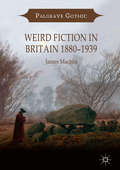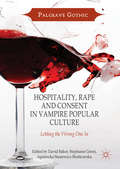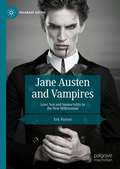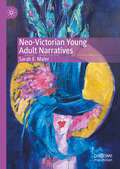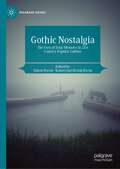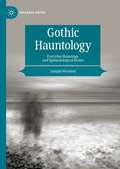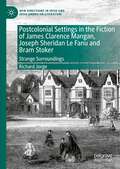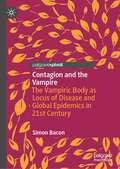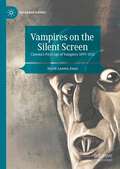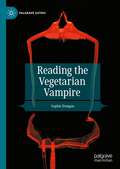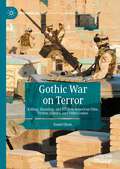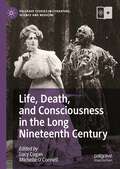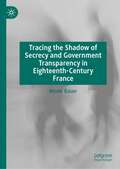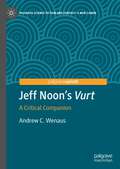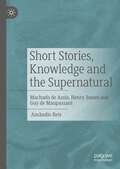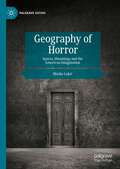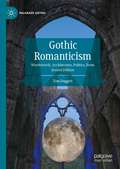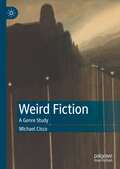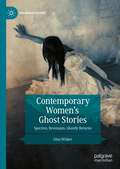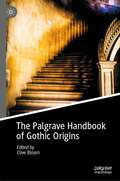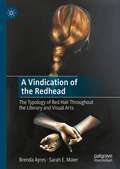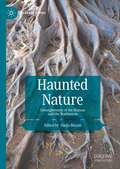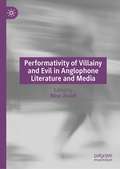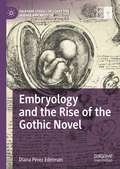- Table View
- List View
Weird Fiction in Britain 1880–1939 (Palgrave Gothic)
by James MachinThis book is the first study of how ‘weird fiction’ emerged from Victorian supernatural literature, abandoning the more conventional Gothic horrors of the past for the contemporary weird tale. It investigates the careers and fiction of a range of the British writers who inspired H. P. Lovecraft, such as Arthur Machen, M. P. Shiel, and John Buchan, to shed light on the tensions between ‘literary’ and ‘genre’ fiction that continue to this day. Weird Fiction in Britain 1880–1939 focuses on the key literary and cultural contexts of weird fiction of the period, including Decadence, paganism, and the occult, and discusses how these later impacted on the seminal American pulp magazine Weird Tales. This ground-breaking book will appeal to scholars of weird, horror and Gothic fiction, genre studies, Decadence, popular fiction, the occult, and Fin-de-Siècle cultural history.
Weird Fiction in Britain 1880–1939 (Palgrave Gothic)
by James MachinThis book is the first study of how ‘weird fiction’ emerged from Victorian supernatural literature, abandoning the more conventional Gothic horrors of the past for the contemporary weird tale. It investigates the careers and fiction of a range of the British writers who inspired H. P. Lovecraft, such as Arthur Machen, M. P. Shiel, and John Buchan, to shed light on the tensions between ‘literary’ and ‘genre’ fiction that continue to this day. Weird Fiction in Britain 1880–1939 focuses on the key literary and cultural contexts of weird fiction of the period, including Decadence, paganism, and the occult, and discusses how these later impacted on the seminal American pulp magazine Weird Tales. This ground-breaking book will appeal to scholars of weird, horror and Gothic fiction, genre studies, Decadence, popular fiction, the occult, and Fin-de-Siècle cultural history.
Hospitality, Rape and Consent in Vampire Popular Culture
by David Baker Stephanie Green Agnieszka Stasiewicz-BieńkowskaThis unique study explores the vampire as host and guest, captor and hostage: a perfect lover and force of seductive predation. From Dracula and Carmilla, to True Blood and The Originals, the figure of the vampire embodies taboos and desires about hospitality, rape and consent. The first section welcomes the reader into ominous spaces of home, examining the vampire through concepts of hospitality and power, the metaphor of threshold, and the blurred boundaries between visitation, invasion and confinement. Section two reflects upon the historical development of vampire narratives and the monster as oppressed, alienated Other. Section three discusses cultural anxieties of youth, (im)maturity, childhood agency, abuse and the age of consent. The final section addresses vampire as intimate partner, mapping boundaries between invitation, passion and coercion. With its fresh insight into vampire genre, this book will appeal to academics, students and general public alike.
Jane Austen and Vampires: Love, Sex and Immortality in the New Millennium (Palgrave Gothic)
by Eric ParisotJane Austen and Vampires is the first book to investigate the literary convergence of Jane Austen and vampires in Austen fanfic after the success of Stephenie Meyer’s Twilight (2005) and Seth Grahame-Smith’s Pride and Prejudice and Zombies (2009). It asks how the shifting cultural values of Austen and the vampire have aligned, and what their connection might mean for their respective contemporary legacies. It also makes a case for reading “low brow” Austen fanfic attentively, as a way to gain meaningful insight directly from Austen fans into the tensions and anxieties surrounding contemporary notions of love, sex, femininity, and Austen’s modern currency. Offering close readings of Austen’s vampire-slaying heroines, vampiric retellings of Pride and Prejudice, and the transformation of Austen herself into a vampire, this book reveals Austen-vampire mashups as messy, complex entanglements that creatively and self-reflexively interrogate modern fantasies of vampire romance. By its unique intersection of Jane Austen with the vampire, the Gothic, fan culture and popular romance, Jane Austen and Vampires adds a new chapter to the history of Austen’s reception, for fans, students and scholars alike.
Neo-Victorian Young Adult Narratives
by Sarah E. MaierNeo-Victorian Young Adult Narratives examines the neo-Victorian themes and motifs currently appearing in young adult fiction—specifically addressing the themes of authorship, sexuality, and criminality in the context of the Victorian age in British and American cultures. This book explicates the complicated relationship between the Victorian past and the turn to Victorian modes of thought on literature, history, and morality. Additionally, Sarah E. Maier aims to determine if the appeal of neo-Victorian young adult fiction rests in or resists nostalgia, parody, and revision. Given the overwhelming prevalence of the Victorian in the young adult genres of biofiction, juvenile writings, gothic, sensation, mystery, and crime fiction, there is much to investigate in terms of the friction between the past and the present.
Gothic Nostalgia: The Uses of Toxic Memory in 21st Century Popular Culture (Palgrave Gothic)
by Simon Bacon Katarzyna Bronk-BaconThis book is an original and innovative study of how Gothic nostalgia and toxic memory are used to underpin and promote the ongoing culture wars and populist politics in contemporary popular culture. The essays collected here cover topics from the spectral to the ecological, deep fakes to toxic ableism, Mary Poppins to John Wick to reveal how the use of an imaginary past to shape the present, creates truly Gothic times that we can never escape. These ‘hungry ghosts’ from the past find resonance with the Gothic which speaks equally of a past that often not only haunts the present but will not let it escape its grasp. This collection will look at the confluence between various kinds of toxic nostalgia and popular culture to suggest the ways in which contemporary populism has resurrected ideological monsters from the grave to gorge on the present and any possibility of change that the future might represent.
Gothic Hauntology: Everyday Hauntings and Epistemological Desire (Palgrave Gothic)
by Joakim WrethedThis book provides a theoretically informed account of Gothic Hauntology. It is distinctive foremost in two ways. It shows hauntology at work in modern as well as older gothic narratives and it has a unique focus on everyday gothic as well as everyday hauntology. The chapters perform a historical circle going from Munro to Poe and then back again, offering novel readings of works by well-known authors that are contextualized under the umbrella of the theme. Anchored in a well-known topic and genre, but with a specific phenomenological framework, this book will be of interest to both students and more advanced scholars.
Postcolonial Settings in the Fiction of James Clarence Mangan, Joseph Sheridan Le Fanu and Bram Stoker: Strange Surroundings (New Directions in Irish and Irish American Literature)
by Richard JorgeThis book explores how three Anglo-Irish writers, J.C. Mangan, J.S. Le Fanu and Bram Stoker, use settings in their short fictions to recreate, depict and confront Ireland’s colonial situation in the nineteenth century. This study provides an innovative approach by targeting a genre (the short story) which has not been explored in its entirety— certainly not within nineteenth century Ireland - much less using a postcolonial approach to the short story. Added to this is the fact that it analyses how these writers used settings as an anticolonial tool. To do so, the book is divided into two major sections, an analysis of Irish settings and non-Irish ones. It works on the premise that all three writers used the idea of displacement to target colonialism and its effects on Irish society. In short, this book addresses a gap in scholarship, as the Irish Gothic short story as a decolonizing tool has not been sufficiently and globally studied.
Contagion and the Vampire: The Vampiric Body as Locus of Disease and Global Epidemics in 21st Century
by Simon BaconThis book examines how the vampire has always been connected to ideas of infection, pollution and disease—even more so in the 21st century where it expresses the horrors of unseen and unstoppable disease and the foreboding and anxiety that accompany viral outbreaks and wider epidemics. Here the vampire gives physical form to the contagion and associated anxieties around the perceived causes and spread of disease, where it can take on many forms from animal to pestilential particulate matter, creeping shadows and even malignant weather systems. If blood is life, it is the body of the vampire that is death. This timely study looks at how and why the vampire continues to fulfil this function and posits that the true patient zero in the 21st century is no longer the dangerous, ancient, outsider from the East but is the undying monster that is Western culture itself.
Vampires on the Silent Screen: Cinema’s First Age of Vampires 1897-1922 (Palgrave Gothic)
by David Annwn JonesThis book is the first study of the vampires in silent cinema, presenting a detailed academic yet accessible discussion of the films themselves and their sources. For the very first time, The Fire Elemental from the Wharton brothers’ The Mysteries of Myra (1916) is identified as cinema’s original vampire, his appearance initiating a rich and variegated period of film production that is currently missing from studies of horror cinema. Exciting and ground-breaking, Vampires on the Silent Screen also discusses Drakula Halála / Dracula’s death (1920), the first ever filmic female vampire in Erich Kober’s Lilith and Ly (1919), and the Dracula lookalike, Count Merlin in Alexander Korda’s Magic (1917) as well as many other productions. A socio-cultural framework with critical highlighting of eco-horror theory is used throughout to draw these unique discoveries together. This project is a must read for any horror enthusiasts out there.
Reading the Vegetarian Vampire (Palgrave Gothic)
by Sophie DunganThis Pivot traces the rise of the so-called “vegetarian” vampire in popular culture and contemporary vampire fiction, while also exploring how the shift in the diet of (some) vampires, from human to animal or synthetic blood, responds to a growing ecological awareness that is rapidly reshaping our understanding of relations with others species. The book introduces the trope of the vegetarian vampire, as well as important critical contexts for its discussion: the Anthropocene, food studies, and the modern practice, politics and ideologies of vegetarianism. Drawing on references to recent historical contexts and developments in the genre more broadly, the book investigates the vegetarian vampire’s relationship to other more violent and monstrous forms of the vampire in popular twenty-first century horror cinema and television. Texts discussed include Interview with the Vampire, Buffy the Vampire Slayer, Twilight, The Vampire Diaries and True Blood. Reading the Vegetarian Vampire examines a new aspect of contemporary interest in considering vampire fiction.
Gothic War on Terror: Killing, Haunting, and PTSD in American Film, Fiction, Comics, and Video Games (Palgrave Gothic)
by Danel OlsonAfter 9/11, the world felt the “shock and awe” of the War on Terror. But that war also exploded inside novels, films, comics, and gaming. Danel Olson investigates why the paranormal, ghostly, and conspiratorial entered such media between 2002-2022, and how this Gothic presence connects to the most recent theories on PTSD. Set in New York/Gotham, Afghanistan, Iraq, and CIA black sites, the traumatic and weird works interrogated here ask how killing affects the killers. The protagonists probed are artillery, infantry, and armored-cavalry soldiers; military intelligence; the Air Force; counter-terrorism officers of the NYPD, NCIS, FBI, and CIA; and even the ultimate crime-fighting vigilante, Batman.
Life, Death, and Consciousness in the Long Nineteenth Century (Palgrave Studies in Literature, Science and Medicine)
by Lucy Cogan Michelle O’ConnellThis book explores how the writers, poets, thinkers, historians, scientists, dilettantes and frauds of the long-nineteenth century addressed the “limit cases” regarding human existence that medicine continuously uncovered as it stretched the boundaries of knowledge. These cases cast troubling and distorted shadows on the culture, throwing into relief the values, vested interests, and power relations regarding the construction of embodied life and consciousness that underpinned the understanding of what it was to be alive in the long nineteenth century. Ranging over a period from the mid-eighteenth century through to the first decade of the twentieth century—an era that has been called the ‘Age of Science’—the essays collected here consider the cultural ripple effects of those previously unimaginable revolutions in science and medicine on humanity’s understanding of being.
Tracing the Shadow of Secrecy and Government Transparency in Eighteenth-Century France
by Nicole BauerThis book traces changing attitudes towards secrecy in eighteenth-century France, and explores the cultural origins of ideas surrounding government transparency. The idea of keeping secrets, both on the part of individuals and on the part of governments, came to be viewed with more suspicion as the century progressed. By the eve of the French Revolution, writers voicing concerns about corruption saw secrecy as part and parcel of despotism, and this shift went hand in hand with the rise of the idea of transparency. The author argues that the emphasis placed on government transparency, especially the mania for transparency that dominated the French Revolution, resulted from the surprising connections and confluence of changing attitudes towards honour, religious movements, rising nationalism, literature, and police practices. Exploring religious ideas that associated secrecy with darkness and wickedness, and proto-nationalist discourse that equated foreignness with secrecy, this book demonstrates how cultural shifts in eighteenth-century France influenced its politics. Covering the period of intense fear during the French Revolution and the paranoia of the Reign of Terror, the book highlights the complex interplay of culture and politics and provides insights into our attitudes towards secrecy today.
Jeff Noon's "Vurt": A Critical Companion (Palgrave Science Fiction and Fantasy: A New Canon)
by Andrew C. WenausThis book offers an examination of Jeff Noon’s iconoclastic debut novel, Vurt (1993). In this first book-length study of the novel, which includes an extended interview with Noon, Wenaus considers how Vurt complicates the process of literary canonization, its constructivist relationship to genre, its violent and oneiric setting of Manchester, its use of the Orphic myth as an archetype for the practice of literary collage and musical remix, and how the structural paradoxes of chaos and fractal geometry inform the novel’s content, form, and theme. Finally, Wenaus makes the case for Vurt’s ongoing relevance in the 21st century, an era increasingly characterized by neuro-totalitarianism, psychopolitics, and digital surveillance. With Vurt, Noon begins his project of rupturing feedback loops of control by breaking narrative habits and embracing the contingent and unpredictable. An inventive, energetic, and heartbreaking novel, Vurt is also an optimistic and heartfelt call for artists to actively create open futures.
Short Stories, Knowledge and the Supernatural: Machado de Assis, Henry James and Guy de Maupassant
by Amândio ReisThis book proposes a comparative approach to the supernatural short stories of Machado de Assis, Henry James and Guy de Maupassant. It offers an alternative to predominantly novel-centric and Anglo-centric perspectives on literary pre-modernism by investigating a transnational and multilingual connection between genre, theme and theory, i.e., between the modern short story, the supernatural and the problem of knowledge. Incorporating a close analysis of the literary texts into a discussion of their historical context, the book argues that Machado, James and Maupassant explore and reinvent the supernatural short story as a metafictional genre. This modernized and innovative form allows them to challenge the dichotomies and conventions of realist and supernatural fiction, inviting their past and present readers to question common assumptions on reality and literary representation.
Geography of Horror: Spaces, Hauntings and the American Imagination (Palgrave Gothic)
by Marko LukićThis book provides a comprehensive reading of a space/place-based experience from the birth of the American horror genre (nineteenth century American Romanticism) to its rise and evolution in the twentieth and twenty-first centuries. Exploring a series of narratives, this study focuses on the role of space and place as key elements for successful articulation of horror. The analysis, therefore, employs different theoretical premises and concepts belonging to human geography, which, while being part of the larger discipline of geography, predominantly directs its attention towards the presence and activities of humans. By connecting such theoretical readings with the continuously evolving American horror genre, this book offers a unique insight into the academically unexplored trans-disciplinary spatially based reading of the genre.
Gothic Romanticism: Wordsworth, Architecture, Politics, Form (Palgrave Gothic)
by Tom DuggettGothic Romanticism: Wordsworth, Architecture, Politics, Form offers a revisionist account of both Wordsworth and the politics of antiquarianism in the late eighteenth and early nineteenth centuries. As a historically-driven study that develops a significant critique and revision of genre- and theory-based approaches to the Gothic, it covers many key works by Wordsworth and his fellow “Lake Poets” Samuel Taylor Coleridge and Robert Southey. The second edition incorporates new materials that develop the argument in new directions opened up by changes in the field over the last decade. The book also provides a sustained reflection upon Romantic conservatism, including the political thought and lasting influence of Edmund Burke. New material places the book in wider and longer context of the political and historical forms seen developing in Wordsworth, and proposes Gothic Romanticism as the alternative line of cultural development to Victorian Medievalism.
Weird Fiction: A Genre Study
by Michael CiscoWeird Fiction: A Genre Study presents a comprehensive, contemporary analysis of the genre of weird fiction by identifying the concepts that influence and produce it. Focusing on the sources of narrative content—how the content is produced and what makes something weird—Michael Cisco engages with theories from Deleuze and Guattari to explain how genres work and to understand the relationship between identity and the ordinary. Cisco also uses these theories to examine the supernatural not merely as a horde of tropes, but as a recognition of the infinity of experience in defiance of limiting norms. The book also traces the sociopolitical implications of weird fiction, studying the differentiation of major and minor literatures. Through an articulated theoretical model and close textual analysis, readers will learn not only what weird fiction is, but how and why it is produced.
Contemporary Women’s Ghost Stories: Spectres, Revenants, Ghostly Returns (Palgrave Gothic)
by Gina WiskerThis book offers new insights on socially and culturally engaged Gothic ghost stories by twentieth century and contemporary female writers; including Shirley Jackson, Angela Carter, Toni Morrison, Ali Smith, Susan Hill, Catherine Lim, Kate Mosse, Daphne du Maurier, Helen Dunmore, Michele Roberts, and Zheng Cho. Through the ghostly body, possessions and visitations, women’s ghost stories expose links between the political and personal, genocides and domestic tyrannies, providing unceasing reminders of violence and violations. Women, like ghosts, have historically lurked in the background, incarcerated in domestic spaces and roles by familial and hereditary norms. They have been disenfranchised legally and politically, sold on dreams of romance and domesticity. Like unquiet spirits that cannot be silenced, women’s ghost stories speak the unspeakable, revealing these contradictions and oppressions. Wisker’s book demonstrates that in terms of women’s ghost stories, there is much to point the spectral finger at and much to speak out about.
The Palgrave Handbook of Gothic Origins
by Clive BloomThis handbook provides a comprehensive overview of research on the Gothic Revival. The Gothic Revival was based on emotion rather than reason and when Horace Walpole created Strawberry Hill House, a gleaming white castle on the banks of the Thames, he had to create new words to describe the experience of gothic lifestyle. Nevertheless, Walpole’s house produced nightmares and his book The Castle of Otranto was the first truly gothic novel, with supernatural, sensational and Shakespearean elements challenging the emergent fiction of social relationships. The novel’s themes of violence, tragedy, death, imprisonment, castle battlements, dungeons, fair maidens, secrets, ghosts and prophecies led to a new genre encompassing prose, theatre, poetry and painting, whilst opening up a whole world of imagination for entrepreneurial female writers such as Mary Shelley, Joanna Baillie and Ann Radcliffe, whose immensely popular books led to the intense inner landscapes of the Bronte sisters. Matthew Lewis’s The Monk created a new gothic: atheistic, decadent, perverse, necrophilic and hellish. The social upheaval of the French Revolution and the emergence of the Romantic movement with its more intense (and often) atheistic self-absorption led the gothic into darker corners of human experience with a greater emphasis on the inner life, hallucination, delusion, drug addiction, mental instability, perversion and death and the emerging science of psychology. The intensity of the German experience led to an emphasis on doubles and schizophrenic behaviour, ghosts, spirits, mesmerism, the occult and hell. This volume charts the origins of this major shift in social perceptions and completes a trilogy of Palgrave Handbooks on the Gothic—combined they provide an exhaustive survey of current research in Gothic studies, a go-to for students and researchers alike.
A Vindication of the Redhead: The Typology of Red Hair Throughout the Literary and Visual Arts
by Brenda Ayres Sarah E. MaierA Vindication of the Redhead investigates red hair in literature, art, television, and film throughout Eastern and Western cultures. This study examines red hair as a signifier, perpetuated through stereotypes, myths, legends, and literary and visual representations. Brenda Ayres and Sarah E. Maier provide a history of attitudes held by hegemonic populations toward red-haired individuals, groups, and genders from antiquity to the present. Ayres and Maier explore such diverse topics as Judeo-Christian narratives of red hair, redheads in Pre-Raphaelite paintings, red hair and gender identity, famous literary redheads such as Anne of Green Gables and Pippi Longstocking, contemporary and Neo-Victorian representations of redheads from the Black Widow to The Girl with the Dragon Tattoo, and more. This book illuminates the symbolic significance and related ideologies of red hair constructed in mythic, religious, literary, and visual cultural discourse.
Haunted Nature: Entanglements of the Human and the Nonhuman (Palgrave Gothic)
by Sladja BlazanThis volume is a study of human entanglements with Nature as seen through the mode of haunting. As an interruption of the present by the past, haunting can express contemporary anxieties concerning our involvement in the transformation of natural environments and their ecosystems, and our complicity in their collapse. It can also express a much-needed sense of continuity and relationality. The complexity of the question—who and what gets to be called human with respect to the nonhuman—is reflected in these collected chapters, which, in their analysis of cinematic and literary representations of sentient Nature within the traditional gothic trope of haunting, bring together history, race, postcolonialism, and feminism with ecocriticism and media studies. Given the growing demand for narratives expressing our troubled relationship with Nature, it is imperative to analyze this contested ground.
Performativity of Villainy and Evil in Anglophone Literature and Media
by Nizar ZouidiPerformativity of Villainy and Evil in Anglophone Literature and Media studies the performative nature of evil characters, acts and emotions across intersecting genres, disciplines and historical eras. This collection brings together scholars and artists with different institutional standings, cultural backgrounds and (inter)disciplinary interests with the aim of energizing the ongoing discussion of the generic and thematic issues related to the representation of villainy and evil in literature and media. The volume covers medieval literature to contemporary literature and also examines important aspects of evil in literature such as social and political identity, the gothic and systemic evil practices. In addition to literature, the book considers examples of villainy in film, TV and media, revealing that performance, performative control and maneuverability are the common characteristics of villains across the different literary and filmic genres and eras studied in the volume.
Embryology and the Rise of the Gothic Novel (Palgrave Studies in Literature, Science and Medicine)
by Diana Pérez EdelmanThis book argues that embryology and the reproductive sciences played a key role in the rise of the Gothic novel in the eighteenth and nineteenth centuries. Diana Pérez Edelman dissects Horace Walpole’s use of embryological concepts in the development of his Gothic imagination and provides an overview of the conflict between preformation and epigenesis in the scientific community. The book then explores the ways in which Gothic literature can be read as epigenetic in its focus on internally sourced modes of identity, monstrosity, and endless narration. The chapters analyze Horace Walpole’s The Castle of Otranto; Ann Radcliffe’s A Sicilian Romance, The Italian, and The Mysteries of Udolpho; Mary Shelley’s Frankenstein; Charles Robert Maturin’s Melmoth the Wanderer; and James Hogg’s Confessions of a Justified Sinner, arguing that these touchstones of the Gothic register why the Gothic emerged at that time and why it continues today: the mysteries of reproduction remain unsolved.
